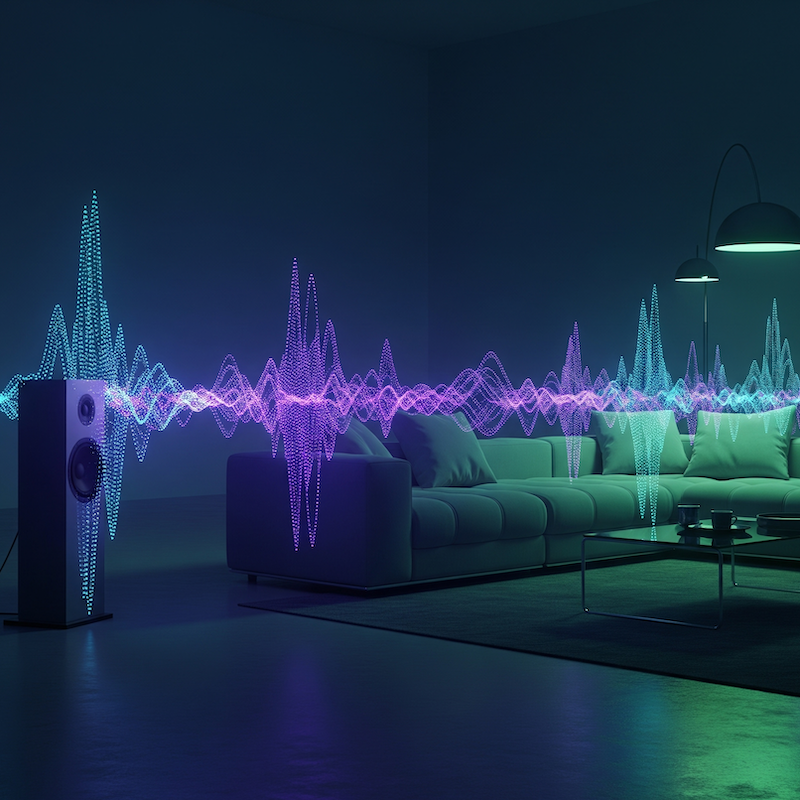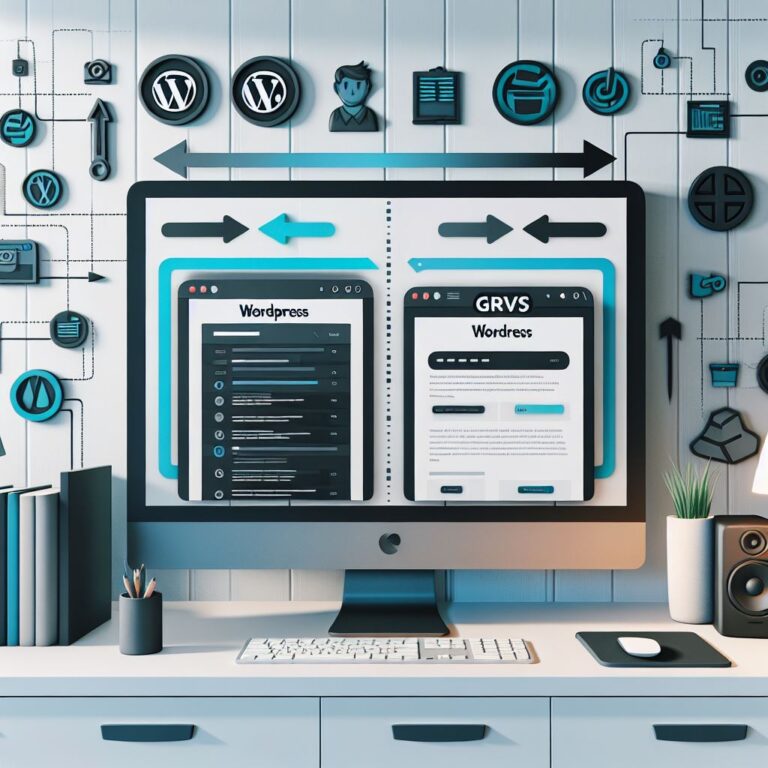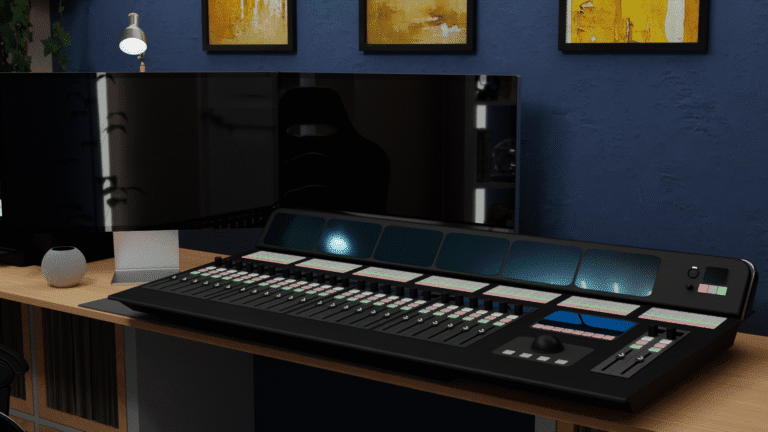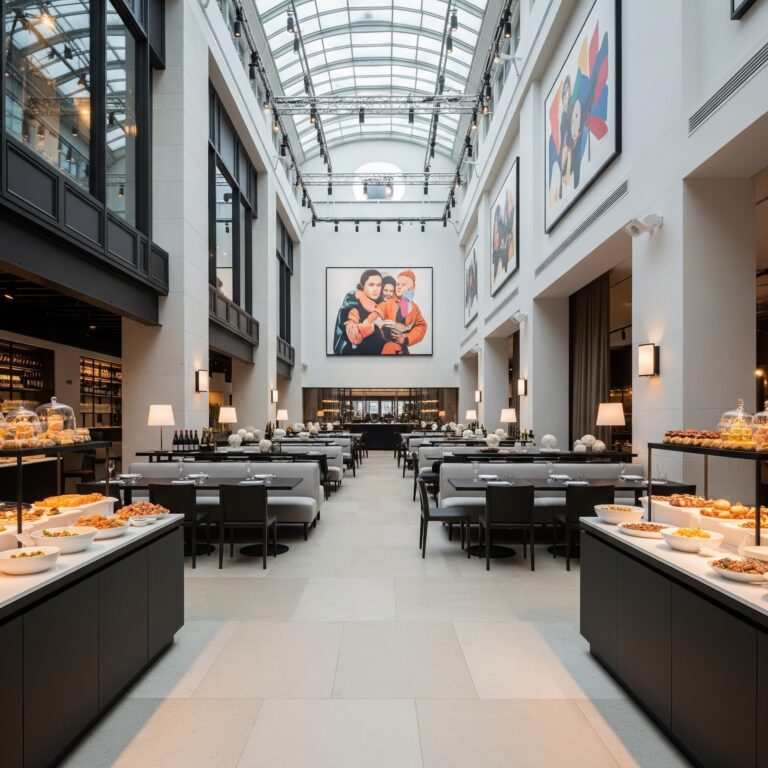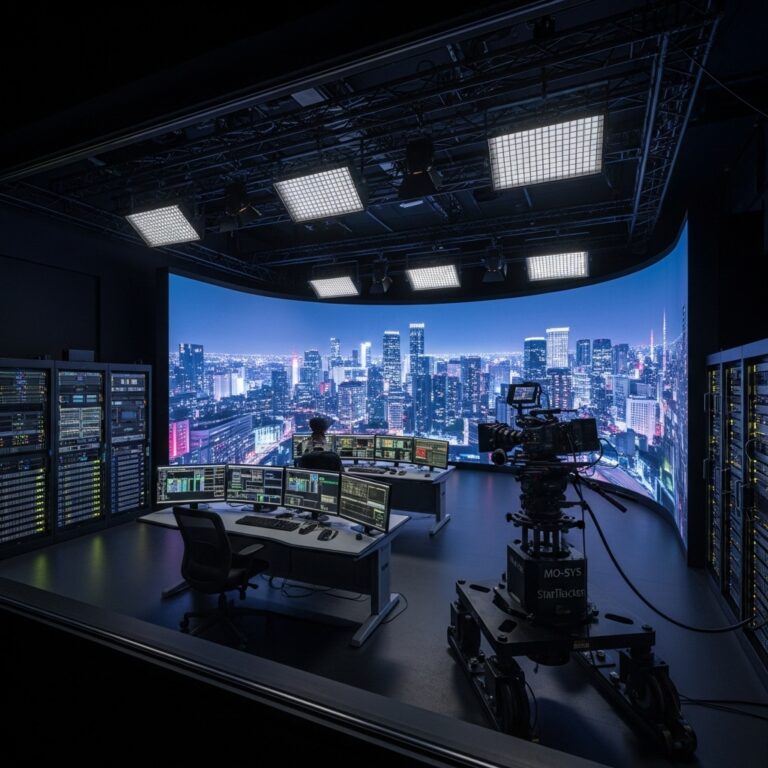Sennheiser Spectera & The Dante Dream: Building the Future of Audio
The Dawn of a New Audio Era
Alright, settle in, grab your favourite beverage (mine’s a ridiculously strong coffee, because, well, deadlines and 2 AM brainstorming sessions, you know?), because we’re about to dive headfirst into something that’s genuinely exciting in the world of audio. If you’ve been following my ramblings for a while, you’ll know I’ve got a bit of a soft spot for networked audio – specifically Dante – and how it can make our lives a whole lot easier. We’ve touched on it before, whether it was wrestling with a small audio rig for bands (remember that one? Simpler times!), or trying to convince Blackmagic ATEM switchers that, yes, audio does exist beyond their MADI inputs (and yes each of those words are links to different articles). It’s a journey, isn’t it?
Well, folks, hold onto your headphones, because Sennheiser has just launched their new Spectera Solution range, and honestly? My inner audio nerd just did a happy little jig. This isn’t just another shiny new microphone or a slightly improved mixer; this feels like a genuine stride towards the future I’ve been dreaming (and occasionally ranting) about. It’s about moving away from tangled nests of cables that look like a particularly aggressive plate of spaghetti, and towards a world where everything just… talks to each other. Seamlessly. In glorious digital perfection.
So, why now? Why is this all becoming such a big deal right this very minute? Well, it’s a perfect storm, really. Our internet speeds are faster than ever (most of the time, anyway, mine still throws a tantrum on Tuesdays), processing power in our gadgets is through the roof, and frankly, the demands of modern production are just getting more intense. We’re not just doing simple gigs anymore; we’re building elaborate theatrical productions, immersive virtual sets, and live broadcasts that span continents. All of that requires audio that’s as flexible, robust, and reliable as humanly (or digitally) possible.
And speaking of ambitious projects, this is where my beloved, albeit still theoretical, Carnaby Media Hub comes into play. For those just joining us, picture this: a sprawling, state-of-the-art facility packed with a theatre, a sound stage, a digital stage (think The Mandalorian levels of cool, but with less space for Grogu), and even bustling radio studios, all humming with creative energy. It’s my ultimate “what if?” project, a blueprint for a truly integrated media powerhouse. We’re actually diving into the nitty-gritty of the Carnaby Media Hub in a dedicated series of posts, so keep an eye out for those if you want the full tour!
But for this post, we’re going to zoom in on how Sennheiser’s Spectera Solution, combined with the magic of Dante, could form the very auditory backbone of such a colossal undertaking. We’re talking about transforming how we approach everything from mic setups to speaker deployment, making it not just more efficient, but genuinely more exciting. We’ll explore the tech, peek into its practical uses, and even gaze into our crystal ball to guess what other audio delights might be just around the corner.
Ready to nerd out a bit? Good. Let’s do this.
2. Understanding the Sennheiser Spectera Solution
Alright, now that we’ve set the scene and I’ve successfully managed to not spill my coffee (small victories, people!), let’s get down to the real reason we’re here: Sennheiser’s brand-spanking-new Spectera Solution. What is it, why should we care, and why does it make my little audio-obsessed heart beat a little faster?
At its core, the Spectera Solution isn’t just a product; it’s a system. Sennheiser, bless their audio-loving souls, seems to have looked at the current landscape of complex productions – where wireless spectrum is getting squeezed tighter than my jeans after Christmas dinner, and reliable audio is absolutely non-negotiable – and said, “Hold my beer, we’ve got this.”
From what I’ve been poring over in the instruction manual (yes, I do read them, mostly, when I’m not just plugging things in until they smoke), the Spectera System is built around a few key players:
- The Base Station: This feels like the brain of the operation, managing the wireless signals and, crucially, getting that audio onto a network. It’s designed to be smart, efficient, and ready to handle whatever you throw at it.
- SEK & DAD Units: These seem to be the clever little bits that connect to your microphones. Think of them as the unsung heroes that turn analogue mic signals into beautiful, clean digital audio that can then travel effortlessly across your network. They’re compact, which is a huge win when you’re trying to hide tech on a busy stage or set.
- Network-Enabled Chargers (like the CHG 70N-C and the Modular L 6000): Now, this might sound boring, but trust me, it’s not. These aren’t just dumb charging stations; they’re network-enabled. That means you can monitor battery status, see when things are charged, and generally keep an eye on your power situation from a central point. No more frantic dashing around backstage trying to find a rogue dead battery five minutes before curtain up. (Don’t ask me how I know that pain.)
So, why is this a “game-changer” and not just another incremental update? It boils down to a few things:
- Unleashing Wireless Potential: The system is designed to navigate increasingly crowded RF environments, ensuring stable, reliable wireless microphone performance. In a world where every single show, every event, every broadcast seems to be fighting for the same limited airwaves, a system that can intelligently manage and optimize its spectrum is pure gold. Less dropout anxiety for everyone!
- Network Integration at its Core: This isn’t just wireless with a network port slapped on; it’s wireless for the network. The Spectera Solution is clearly built with Dante (and other IP protocols) in mind, making it effortless to integrate into existing or planned networked audio systems. This means fewer analogue conversions, shorter signal paths, and ultimately, cleaner, more dependable audio.
- Scalability and Flexibility: Need more channels? Want to reconfigure quickly? A networked system, with components like Spectera, allows you to do just that. You can expand your mic count, route signals to different rooms, or change your setup on the fly, all with a few clicks rather than a frantic re-patching session that leaves you sweating and covered in dust. It means less tearing down and setting up, which, if you’ve ever had to coil a thousand miles of XLR cable, you’ll know is a blessing.
- Remote Control and Monitoring: With the WebUI and LinkDesk software mentioned in the manual, you get comprehensive control and monitoring capabilities. Adjust settings, check signal strength, and keep an eye on everything from a central location. It’s like having a superpower, but for audio engineers. (Though I’d still prefer the ability to teleport directly to the catering table.)
Diving a Little Deeper into the Spectera Magic
You want more technical nitty-gritty? You got it! But don’t worry, I won’t get too bogged down, because my brain also starts to fog over after too many acronyms.
What’s really fascinating about Spectera is how it handles the actual transmission of audio and data. It operates using ultra-wideband (UWB) technology – think of it as a super-efficient, low-power radio signal spread across a very broad frequency spectrum. This is a clever trick because it makes the system incredibly robust and less susceptible to interference from other wireless devices that might be hogging up narrower frequency bands. It’s like having a superhighway for data, but instead of one big lane, it’s spread out over a hundred smaller, parallel paths. This helps keep things stable even in the busiest RF environments, which, let’s face it, is basically every single venue these days.
The manual also mentions different Link Modes, which is neat. These modes allow you to optimize the system for your specific needs. For example, you might have a mode for super-low latency where every millisecond counts (like live theatre), or another for maximum range when you’re covering a massive stage or an outdoor event. This flexibility means you’re not stuck with a one-size-fits-all approach; you can tailor the system to deliver the best performance for your gig, which, as anyone who’s had to improvise solutions on the fly knows, is a lifesaver.
The Spectera Bodypack: A True Multi-Tasker (and a Relief for Performers!)
Now, let’s talk about the real hero for the performers: the Spectera bodypack. Traditionally, if a performer needed a wireless microphone and in-ear monitors (IEMs), they’d be strapped with two separate belt packs. One for the mic, one for the ears. It’s clunky, uncomfortable, and frankly, a bit of a wardrobe nightmare.
But here’s where Spectera flexes its muscles: its bodypack isn’t just a broadcast device for the microphone; it also has built-in receiving capabilities for in-ear monitoring. This means you only need one belt pack on the performer. One! Can you imagine the sighs of relief from actors, singers, and presenters everywhere? Less bulk, more freedom of movement, and far fewer bits to snag on costumes. It’s a small detail that makes a massive difference to the people who are actually wearing the tech.
And it gets better! This bidirectional capability means that not only is the performer sending their audio to the sound desk, but they’re also receiving their monitor mix from the desk, all through the same single, svelte little pack.
Control-wise, it’s a dream for us behind the scenes too. All the settings on those belt packs – mic gain, frequency adjustments, even which monitor mix they’re receiving – can be changed remotely from the control software (that lovely WebUI or LinkDesk we mentioned). No more running onto stage mid-performance to tweak a mic. But here’s the best bit for the performer: while we have the ultimate control, they can still adjust their personal IEM levels using a physical dial on the pack if they want to. It’s the perfect balance of central control for the engineer and immediate comfort adjustment for the artist. Truly genius.
Connecting the dots, the Spectera Solution feels like Sennheiser’s definitive answer to the call for professional-grade audio systems that are ready for the all-IP future. It’s a move towards a leaner, smarter, and ultimately more powerful workflow, where audio isn’t just carried by cables, but intelligently routed and managed across a digital superhighway.
It’s exciting because it simplifies the complex, and in our world, anything that takes some of the logistical headache out of production so we can focus on the creative magic is a win in my book.
The All-Dante Dream: Building a Networked Audio Backbone & The Kit
Alright, let’s roll up our sleeves and get into the juicy details of why we’re picking these particular pieces of gear for our ultimate Dante dream setup. It’s not just about throwing expensive kit at a problem; it’s about strategic choices that build a robust, flexible, and future-proof system. Think of it as carefully selecting the superheroes for our audio Avengers team.
Dante’s Dominance: The Ubiquitous Unifier
So, Dante. I’ve probably said it before, but it bears repeating: it’s not just a fancy protocol; it’s the gold standard for audio networking. It allows hundreds of channels of pristine digital audio to zip around over standard Ethernet cables with virtually no latency. This means less cabling (hooray for fewer spaghetti monsters!), fewer potential points of failure, and incredible flexibility in routing any audio source to any destination. It’s truly transformed how we design and operate audio systems, liberating us from the tyranny of analogue snakes and their associated hums and buzzes.
Building a Truly Dante Setup (and Strategically Bridging the Gaps)
The ideal scenario for a facility like the Carnaby Media Hub is a system where everything is native Dante. This keeps the signal path pure, simple, and incredibly powerful.
Our core components for the ultimate Dante network would be:
- The Brains (Digital Mixing Console): Yamaha Rivage PM7 (CSD-R7)
- Why this pick? The Yamaha CSD-R7 Digital Mixing Console (the core of the RIVAGE PM7 system) isn’t just a mixer; it’s a command centre designed for demanding, high-channel-count environments. Its datasheet highlights its “superior capability of processing digital audio signals of up to 144 input, 60 MIX, 36 MATRIX, and two STEREO channels” at 96 kHz. That’s a lot of audio, perfect for handling everything from a complex theatre production to a bustling live music event. Crucially, it boasts multiple HY card slots, making it inherently Dante-ready. The ability to connect up to 8 RPio units via TWINLANe ring also means seamless integration with our chosen stage boxes, keeping everything on Yamaha’s ultra-low latency ecosystem. Plus, dual power supply units built-in? Reliability, my friends, reliability. My anxiety levels just dropped by 10%.
- The Ears & Mouth (I/O Racks): Yamaha RPio622
- Why this pick? Complementing the PM7, the Yamaha RPio622 I/O rack is where the real-world audio meets our digital network. Its six RY card slots offer incredible flexibility for analogue and digital I/O expansion. This means we can configure it with the exact number of mic inputs, line outputs, or digital AES/EBU connections we need for any given space. Dual HY slots further enhance its Dante (or rather, TWINLANe, Yamaha’s proprietary network, which then bridges to Dante) capabilities, handling massive channel counts. Redundant power supplies are also standard here, reinforcing that mission-critical stability. This unit is the workhorse that ensures every microphone, every instrument, every playback device gets onto the network with pristine clarity.
- The Wireless Wonders: Sennheiser Spectera Solution & Shure ULX-D
- Why this pick? We’ve already gushed about the Sennheiser Spectera Solution (those clever multi-tasking bodypacks!). Its UWB technology and integrated IEM capabilities make it a cutting-edge choice for high-density wireless environments. For sheer channel count and robust performance, we’d also lean on Shure ULX-D Wireless Microphone Systems. While Spectera is our future-forward hero, the ULX-D provides rock-solid, network-ready wireless that’s already a proven industry standard for a wide range of applications, offering fantastic digital audio quality and direct Dante output. A mix-and-match approach here gives us the best of both worlds: innovation and battle-tested reliability.
- The Digital Bridges (Dante AVIO Adapters): Audinate’s Little Heroes
- Why this pick? Not every piece of gear is born with a Dante port, and that’s okay! This is where the Audinate Dante AVIO adapters come into their own. We’d stock up on a variety:
- Analog Input/Output AVIOs: These are the bread and butter for connecting any traditional analogue gear – vintage synths, guitar amps, outboard effects. They convert line-level analogue audio to Dante (and vice-versa) with excellent audio quality (e.g., the 2-channel Analog Output adapter boasts >100dB dynamic range).
- AES3/EBU AVIOs: For digital audio gear that uses the AES3 standard (like some higher-end playback devices or older digital mixers), these provide a direct digital bridge to the Dante network, maintaining signal integrity.
- USB/USB-C AVIOs: These are invaluable for connecting laptops, tablets, or other USB-audio devices directly to the Dante network without needing drivers. Perfect for presentations, quick playback, or even simple recording setups on the fly.
- Bluetooth AVIOs: Yes, Bluetooth on a professional network! This is surprisingly useful for casual playback from mobile devices, or even quickly piping in audio from a presenter’s phone during a conference. It adds incredible flexibility for those less-critical (but still important) audio needs.
- These adapters are compact, PoE-powered (one less power supply to worry about!), and automatically discovered by Dante Controller – pure plug-and-play magic. They really embody the “network everything” philosophy without breaking the bank or forcing wholesale equipment replacement.
- Why this pick? Not every piece of gear is born with a Dante port, and that’s okay! This is where the Audinate Dante AVIO adapters come into their own. We’d stock up on a variety:
Playback & Recording: Capturing and Delivering with Precision
In a modern media hub, recording and playback solutions need to be versatile, reliable, and deeply integrated with the network.
- The Multitrack Maestro (Recording): JoeCo BlackBox BBR64-DANTE Recorder
- Why this pick? When it comes to capturing live multi-channel audio, the JoeCo BBR64-DANTE is a phenomenal choice. Its flyer proudly states it records and replays “up to 64 channels of audio data from a Dante network using standard Broadcast WAV files.” The key here is “computer-free” operation for live performance environments. No more worrying about operating system updates, driver conflicts, or software crashes mid-show (a common nightmare, trust me!). It’s a dedicated, robust recorder that interfaces directly with our Dante network, providing rock-solid reliability for capturing performances, rehearsals, or broadcast feeds. Plus, it can record 8 channels of analogue alongside 56 channels of Dante – brilliant for capturing audience mics or external sources directly.
- The Reliable Workhorse (Playback & Recording): TASCAM SS-CDR250N/SS-R250N
- Why this pick? For everyday playback, spot effects, and simpler recording tasks, the TASCAM SS-CDR250N (and its sister unit, the SS-R250N) is an industry stalwart. While its primary interface isn’t Dante, its network capabilities (Telnet, FTP, network folder access) make it highly compatible with a networked workflow. We can easily get audio to and from it via Dante AVIO adapters, or transfer files over the network. Its reliability, robust build, and comprehensive control options (including RS-232C for integration with larger control systems) make it perfect for cues, background music, and archival recording where a dedicated multitrack recorder might be overkill. It’s the dependable Swiss Army knife of audio playback.
Network Infrastructure: The Superhighway Itself
- The Network Switches: Ubiquiti Enterprise Campus 48 PoE
- Why this pick? You can have the fanciest audio gear in the world, but if your network backbone is flaky, you’re sunk. For a campus-wide solution like CMH, the Ubiquiti Enterprise Campus 48 PoE switch is an excellent choice. “Enterprise Campus” says it all, really. These are robust, managed switches designed for high-density, demanding network environments. Crucially, they offer Power over Ethernet (PoE+) on all 48 ports (hence the “48 PoE” in the name), which is a game-changer for Dante devices and AVIO adapters. This means a single Ethernet cable can deliver both data and power, drastically reducing cable clutter and simplifying installations. Their management features allow for precise control over VLANs (keeping our audio traffic isolated and safe!) and Quality of Service (QoS), ensuring our low-latency audio always gets priority. They’re built for reliability and scalability, exactly what a hub like CMH needs to thrive.
Redundancy & Security: Sleep Easy, Audio Engineers
We touched on this before, but it’s worth reiterating: in a place like CMH, downtime isn’t an option. Our chosen gear supports primary and secondary Dante networks, meaning every critical device has two network connections. If one cable or switch path fails, the audio seamlessly reroutes. This built-in redundancy is essential for live performances, broadcasts, and any scenario where “the show must go on.”
Similarly, robust network security, largely managed by our Ubiquiti switches’ VLAN capabilities, keeps our sensitive audio networks isolated from general IT traffic. No more accidental Spotify concerts over the main PA – unless it’s a very deliberate creative choice!
The Carnaby Media Hub in Practice: Applying Spectera & Dante
Alright, so we’ve waxed lyrical about the individual pieces of tech – the brilliant Spectera, the ubiquitous Dante, the rock-solid Yamaha console, and all those clever little adapters. But what does it all mean when you pull it together in a real, living, breathing (even if still theoretical) production facility like the Carnaby Media Hub?
Well, the CMH isn’t just a collection of cool rooms; it’s designed to be a bustling ecosystem where different types of productions happen simultaneously, often requiring shared resources and seamless transitions. We’re talking a proper theatre, massive sound stages for film and TV, a cutting-edge “Volume” (think LED walls and virtual sets!), and, of course, the buzzing radio studios.
This diversity is precisely why a networked audio approach, with Dante as its spine and Spectera as its cutting-edge wireless arm, is not just a nice-to-have, but an absolute necessity. It’s about efficiency, adaptability, and making sure that whether you’re miking up an opera singer, recording foley for a blockbuster, or capturing dialogue on a virtual set, the audio just works. It’s about designing a system that’s as flexible as the creatives who’ll be using it.
So, let’s talk about how our carefully curated kit list from earlier would actually be deployed in these specific CMH venues. It’s less about installing unique gear in each room and more about strategically deploying and reconfiguring shared resources.
The Theatre: Grand Scale, Grand Sound
In the theatre, where pristine vocal clarity and immersive sound design are paramount, our setup would lean heavily on:
- Dante Amps with Passive Speakers (D&B audiotechnik D90 & V-Series): For the main house PA, this is the gold standard. The d&b D90 amplifiers (which, as their datasheet confirms, offer redundant Milan/Dante inputs and serious power delivery) would feed a d&b V-Series line array system. Why this combo? Because for a permanent installation, you get unparalleled audio quality, precise control, and the modularity of the V-Series allows us to tailor the system perfectly to the theatre’s acoustics and seating. The D90’s ability to drive high-voltage loudspeakers means we’re getting every drop of performance out of those beautiful passive cabinets. It’s a classic pairing, updated for the networked age, ensuring every whisper and every booming orchestral hit is delivered with breathtaking fidelity.
- Sennheiser Spectera Solution: All those musical theatre performers, all those nuanced spoken word performances? This is where Spectera shines. Its density and reliability, especially with those fantastic one-pack-for-mic-and-IEM bodypacks, would make life so much easier for both the performers and the audio team. Imagine not having to strap two packs onto someone! We’d have Spectera Base Stations strategically placed for optimal coverage, feeding directly into our Dante network.
- Yamaha RPio622 Stageboxes: Distributed around the stage and orchestra pit, these would be the primary interface for all wired microphones, instrument inputs, and any other analogue sources. Their flexibility and seamless integration with the Yamaha PM7 console mean we can route anything, anywhere, quickly.
Production Stages (Sound Stages): Versatility is King
These are the blank canvases, where one day you might be filming a car chase, and the next, a talking dog commercial. Flexibility is the key, so our setup here would prioritize rapid reconfiguration:
- Powered Speakers with Dante Built-In: This is where these bad boys truly earn their keep. Speakers from Meyer Sound, QSC, or JBL with native Dante would be deployed. The beauty? Just run an Ethernet cable (which can also carry power via PoE+ if the speaker supports it and the Ubiquiti switch is configured) and you’ve got audio. Need to set up a surround array for playback? Done in minutes. Need a dozen small monitors for a complex dialogue scene? Easy peasy. Their self-contained nature means less external amplification and less cabling.
- Sennheiser Spectera & Shure ULX-D: Both wireless systems would be crucial here. Spectera for high-channel, high-fidelity needs, especially where performer comfort is key (e.g., actors on a set). Shure ULX-D provides additional robust channels for general set use, production comms, or even instrument wireless.
- Yamaha RPio622 Stageboxes & Dante AVIO Adapters: Again, RPio622s would serve as the main high-density I/O points for wired mics and instruments. But the Dante AVIO adapters (especially the Analog Input/Output, USB, and AES3 versions) would be invaluable here for rapid, on-the-fly connections. Director wants to play a reference track from their laptop? USB AVIO. Need to quickly route audio from an older piece of gear? Analogue AVIO. They are the ultimate “problem solvers” for the inevitable curveballs thrown on a busy sound stage.
- Radial DAN-TX Dante DI Boxes: For direct instrument input to the network, the Radial DAN-TX is perfect. Its ability to take instrument, line, or even consumer-level inputs (¼”, RCA, 3.5mm) and put them straight onto Dante means instruments like guitars, bass, or keyboards can be cleanly routed without the need for traditional analogue DI boxes and mic lines back to a stage box. This is especially handy when you have a constantly shifting stage layout.
The Volume (Digital Stage): Immersive Audio, Immersive World
This is where the magic of virtual production happens, and audio needs to be as adaptable as the LED walls. Immersive sound is vital for truly selling the illusion:
- Primarily Powered Speakers with Dante Built-In: This is their natural habitat. With an LED volume, you often need to place speakers precisely for immersive audio playback, sound effects, or even as practical sound sources within the virtual world. The individual routing and control offered by Dante-enabled powered speakers makes this incredibly efficient. We can literally map sounds to virtual positions and have them play from corresponding physical speakers with pinpoint accuracy.
- Sennheiser Spectera Solution: For actors interacting with the virtual environment, Spectera’s precise wireless performance and integrated IEMs are critical. The performer hears their monitoring mix, perfectly synced, while their dialogue is captured cleanly, ready to be blended into the virtual soundscape.
- Dante AVIO Adapters: These are hugely important here for integrating various playback devices (laptops, media servers) or bringing in external sound design workstations directly to the network. The flexibility to quickly patch in various sources and destinations is paramount in an environment that’s constantly being reconfigured for different virtual sets.
The Radio Studios: A Future Integration Story
As for the radio studios, they’ll have their own dedicated Audio over IP (AoIP) system – usually something like AES67 or Ravenna. The beauty of Dante is its interoperability. We’ll be able to seamlessly tie our central Dante network into their AoIP system, allowing for easy audio exchange between the broadcast studios and the production spaces. But the intricacies of that specific integration? Well, that’s a post for another day, because we’ve already got enough exciting tech on our plate here!
Flexibility Across Venues: The CMH Superpower
The real takeaway here is the interconnectedness. With a robust Ubiquiti Enterprise Campus 48 PoE backbone, supporting all those Dante-enabled devices and providing PoE+ for our AVIOs and some powered speakers, audio resources become truly fungible. A channel from a wireless mic used in the theatre can be routed to the sound stage for recording, or to the Volume for an ADR session. A playback track from the sound stage can be sent to the theatre’s PA. It’s about breaking down the silos and creating a fluid, adaptable audio ecosystem. It means less time wasted on patching and re-patching, and more time making incredible content.
This comprehensive networked approach is what truly makes the Carnaby Media Hub a blueprint for future-proof media production. If you’re curious about the deeper architectural and operational blueprints for the Carnaby Media Hub – its various spaces, the full IT network, and all the non-production goodies – you can explore the dedicated series here: The Carnaby Media Hub Series. Trust me, it’s quite the rabbit hole, so make sure to check back weekly for the latest instalment from this series!
Beyond the Tech: Benefits and Future Vision
So, we’ve talked about Dante, we’ve raved about Spectera, and we’ve meticulously detailed how all this fantastic gear slots into our hypothetical, but oh-so-desirable, Carnaby Media Hub. But beyond the shiny specs and the satisfying click of a networked connection, what are the real, tangible benefits of going all-in on this kind of networked audio ecosystem? And what does the future hold for this incredible technology?
The Undeniable Benefits: Why We Do This (Besides Just Loving Gadgets)
It’s easy to get lost in the technical weeds, but let’s bring it back to why this approach is genuinely transformative for anyone involved in audio production. For a start, there’s a surprising level of simplicity. I know, “simple” and “IP network” don’t often go hand-in-hand in the minds of many (including my own, usually!). But truly, once a Dante network is set up, routing audio becomes unbelievably simple. Imagine being able to drag and drop connections in Dante Controller, and suddenly a mic on Stage A is feeding a mixer in the Theatre. This is a massive leap from wrestling with massive, heavy, expensive analogue multi-core cables that often require a forklift to move and an hour to trace. It’s an elegant, efficient solution that drastically cuts down on setup and teardown times, and frankly, my back is eternally grateful.
Then we have flexibility and adaptability, which is absolutely huge for a multi-purpose facility like the CMH. Need to quickly reconfigure a sound stage from a small vocal booth to a full-band live recording setup? Want to seamlessly send a rehearsal feed from the theatre directly to an edit suite across the campus? With a networked backbone, it’s all about software routing rather than physical re-patching. This means our spaces are constantly ready for whatever crazy creative ideas get thrown at them. This leads directly to impressive scalability. If you start small and then need to grow, it’s generally no problem. Need to add another 16 channels of wireless mics? Just plug in another Spectera Base Station. Need more inputs in a different room? Drop in another RPio unit or a few Dante AVIOs. The system can expand organically, without requiring a complete overhaul of your core infrastructure. My wallet might not agree with the “no problem” part of adding more kit, but the system certainly handles it with grace!
And of course, we can’t forget reliability and redundancy. As we discussed, building in redundant networks and power supplies means fewer sleepless nights for the audio crew. If one cable fails, there’s a backup to seamlessly take over. If a network switch gets grumpy, another one on a redundant path steps in. In live production, where “the show must go on” is literally the mantra, this kind of built-in peace of mind is truly priceless. Finally, there’s the compelling argument for long-term cost-effectiveness. While the initial investment in high-end networked gear might seem steep, consider the long game. Less cabling, significantly faster setup and troubleshooting times (meaning less crew hours), and a system that can easily adapt to new technologies without constant rip-and-place cycles. Over time, the savings in labour, infrastructure, and sheer stress really start to add up. It’s not just about buying new toys; it’s an investment in efficiency and sanity.
The Future Vision: Where Do We Go From Here?
This is the fun part – gazing into the audio crystal ball. What’s next for Spectera, Dante, and networked audio as a whole?
Let’s start with the evolution of Spectera. Sennheiser has openly hinted at or confirmed that they’re working on expanding the Spectera lineup beyond the current bodypack and SEK/DAD units. This means we can definitely expect dedicated Spectera handheld microphone transmitters in the not-too-distant future. This will be a massive leap, bringing the UWB advantages – like increased density and reliability – to the most common wireless mic form factor. Beyond that, I’d also wager we’ll see more integrated form factors; perhaps even Spectera-enabled podium mics or boundary layer microphonesdesigned specifically for conference rooms and lecture halls, all seamlessly joining the network without bulky external converters.
Then there’s the increasing ubiquity of Dante, and networked AV in general. Dante is already the de facto standard for audio networking, but its reach will only continue to grow. We’re already seeing much tighter integration with video (hello, Dante AV!) and control systems all operating over standard IP. Imagine a future where your entire production setup – audio, video, lighting, comms, and even stage automation – is all running on a single, unified IP backbone. Troubleshooting then becomes a single network issue to resolve, rather than a frantic hunt through disparate analogue systems. It’s the ultimate convergence, promising to simplify workflows and open up mind-boggling new creative possibilities. We might even reach a point where Dante chips are embedded into everything, from instruments to smart speakers.
And finally, a bit more speculatively, let’s consider the role of AI in audio production. Imagine AI-powered systems living on your Dante network. We could see intelligent routing that automatically optimizes signal paths based on workload, or predictive maintenance that warns you of a failing component before it actually becomes an issue and brings down a show. Or even AI-assisted mixing that learns your preferences and helps you achieve perfect mixes faster than ever before. It might sound like something out of a sci-fi movie, but the fundamental building blocks are already here with robust networked audio systems. We’re already witnessing AI taking on some basic tasks, and with a unified, high-bandwidth network providing the foundation, the possibilities are truly endless (and only slightly terrifying, in a good way!).
Ultimately, the combination of groundbreaking wireless like Sennheiser Spectera and the unwavering reliability of a Dante network isn’t just about making our lives easier (though that’s a huge bonus, obviously!). It’s about unlocking new creative potential, enabling more ambitious productions, and actively future-proofing our facilities against the ever-accelerating pace of technological change. It’s an investment in a smarter, more efficient, and frankly, a much more exciting future for audio.
What are your thoughts?
Are you as excited about the future of networked audio as I am (or do you think I’ve had too much coffee)? What other technologies do you see converging with audio in the next few years? And for all you audio pros out there, what’s yourbiggest networked audio dream (or nightmare)? Let’s chat either in the comments of the social post that brought you here, or drop me a message using the contact form.


